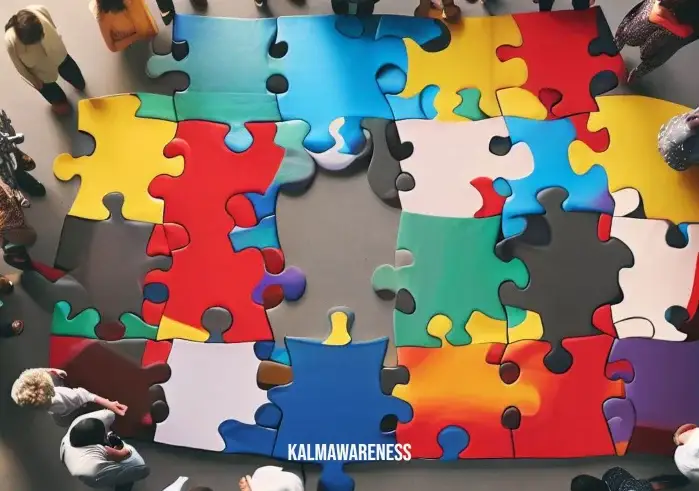Navigating Change: Cultivating Resilience and Growth
Change is a constant force in our lives, often disruptive and challenging, yet equally fertile ground for growth and self-improvement. Learning how to navigate change is a fundamental skill that can reshape our perspective and approach to life. This journey necessitates patience, a strong emotional muscle, empathy, and the capacity to sit with uncomfortable feelings. Through this article, we will explore the different facets of change, and how to approach it in a healthier, more resilient manner.
Resilience Amidst Change
Resilience is the art of bouncing back, or in other words, your capacity to recover quickly from difficulties. It is what allows us to rebuild our lives after a crisis or hardship.
“Change is inevitable, but personal growth is a choice.”
In understanding how to navigate change, it is essential to build your emotional muscle, which equips you to handle the trials of life more effectively. Moreover, a stable mind is an asset, enabling you to maintain calmness and clarity even amidst the stormiest times.
Creating a mantra on embracing difficulty can also serve as a powerful reminder that every hardship presents an opportunity for growth. To foster resilience, it’s not about eliminating change or hardship from our lives, but rather learning how to ride the waves of change with grace and courage.
Empathy and Change
Empathy and resilience go hand-in-hand when navigating change. Understanding how empathy builds resilience can be a game-changer in your journey. It allows us to better understand and share the feelings of others, fostering a deeper connection and mutual support in times of upheaval.
Change often triggers an emotional response, and learning how to sit with uncomfortable feelings is a vital part of the process. It’s about acknowledging these emotions, not suppressing them, and recognizing that it’s okay to feel down. Indeed, there’s even an upside to feeling down.
Remember, no one is an island in times of change. Surrounding yourself with strong friends who can empathize with your situation, offer guidance, and provide a listening ear can be invaluable. Together, you can weather any storm.
In the next section, we will delve into mindfulness and self-care as crucial elements in navigating change. We will learn how cultivating a meditation practice and embarking on self-nurturing actions can not only help you cope with change but also propel you forward towards personal growth.

Mindfulness and Self-Care: Essential Tools to Navigate Change
In navigating change, one cannot overstate the importance of mindfulness and self-care. When we face change, it’s easy to get lost in anxiety and fear, forgetting to be present and care for ourselves. However, these practices can serve as our compass, helping us remain balanced and resilient in the face of change.
Mindfulness: The Art of Being Present
Mindfulness is a mental state achieved by focusing one’s awareness on the present moment while calmly acknowledging and accepting one’s feelings, thoughts, and bodily sensations. It can be a powerful tool in learning to navigate change, helping us to stay grounded amidst the uncertainty.
The Role of Mindfulness in Navigating Change
- Awareness: Mindfulness fosters a heightened state of awareness. This can help us to be more aware of our feelings and how we are reacting to change.
- Acceptance: By practicing mindfulness, we learn to accept our present reality without judgement. This acceptance is a crucial part of embracing difficulty and navigating change.
- Calmness: Mindfulness brings a sense of calm and peace, allowing us to better manage stress and anxiety that often come with change.
Practicing mindfulness does not require a significant commitment. Even a short 7-minute chakra tuneup or a 30-day meditation challenge can make a big difference. Remember, the journey of mindfulness is about consistency, not intensity.
Self-Care: Nurturing the Self Amidst Change
When navigating through change, self-care is not a luxury, but a necessity. It is about taking time to clear your mind, saying yes to yourself, and nurturing your mental, emotional, and physical well-being.
The Importance of Self-Care in Navigating Change
| Self-Care Aspect | Why It Matters | How to Incorporate It |
|---|---|---|
| Physical | Training your pain and taking care of your physical health will give you the energy to handle change. | Regular exercise, a balanced diet, and enough sleep are essential. |
| Mental | Maintaining a positive and stable mindset helps in managing stress and anxiety. | Incorporate practices such as mindfulness and meditation. A 7-day meditation challenge can be a good starting point. |
| Emotional | Attending to your emotional health enables you to process your feelings and reactions healthily. | Acknowledge and validate your feelings, seek support when needed, and practice self-nurturing. |
| Spiritual | Connecting with your inner self can provide strength and comfort in times of change. | Practices such as meditation, yoga, or spending time in nature can help nurture your spiritual health. |
Finally, remember that it’s okay to slow down. In fact, sometimes, it’s necessary. Change can be overwhelming, but slowing down to enjoy life more is a potent remedy against stress and anxiety. It gives you the opportunity to take a deep breath, reassess your situation, and approach change from a place of strength rather than fear.
To navigate change effectively, the application of mindfulness and self-care is non-negotiable. They equip you with the mental and emotional fortitude to weather the storm and emerge stronger. Remember, change is inevitable, but it is how we respond to it that truly matters.
As we approach the conclusion of this guide, we will explore how continuous learning and growth mindset can help us further thrive amidst change. These are powerful tools that can turn change from a threat into an opportunity for personal development.

Continuous Learning and Growth Mindset: Expanding Horizons to Navigate Change
Change, by its very nature, can seem daunting and intimidating. Yet, when we embrace a growth mindset and pursue continuous learning, we not only learn how to navigate change, but we also transform it into an opportunity for personal development and growth.
Continuous Learning: A Lifelong Pursuit
Lifelong learning is the “ongoing, voluntary, and self-motivated” pursuit of knowledge for either personal or professional reasons. Continuous learning helps us adapt to new environments and challenges, making it a key component in learning how to navigate change.
In the words of BB King, “The beautiful thing about learning is that nobody can take it away from you.” And it’s true. Whether you’re embracing a 30-day meditation challenge or reading ‘He Does a Body Good’ to understand the importance of physical health, every bit of knowledge you gain becomes a part of you, empowering you to face change with confidence.
Growth Mindset: The Power of Potential
Dr. Carol Dweck, a renowned psychologist, introduced the concept of ‘growth mindset’. It is the belief that our abilities and intelligence can be developed through dedication and hard work. It’s a view of learning and intelligence as fluid and changeable, rather than static.
This mindset plays a crucial role in navigating change. As Walt Disney once said, “All our dreams can come true, if we have the courage to pursue them.” A growth mindset fosters this courage. It helps us see change not as an insurmountable challenge, but as a chance for growth and development. For example, with a growth mindset, one might view feelings of discomfort as an opportunity for building emotional muscle, thus turning an initially negative experience into a transformative one.
Blending Continuous Learning and Growth Mindset
By combining a growth mindset with a commitment to continuous learning, we build resilience and adaptability – two essential traits for navigating change.
Here are three strategies to cultivate these attributes:
- Embrace Challenges: Instead of shying away from challenges, embrace them. They are opportunities for learning and growth. You might even choose to undertake a 7-day meditation challenge to boost your mental resilience.
- Learn from Criticism: Use criticism as a tool for self-improvement. It can offer valuable insights for personal growth and help you to stay cool under pressure.
- Celebrate the Success of Others: By celebrating others’ successes, we open ourselves to learning from their experiences, fostering a strong sense of empathy that can support us during times of change.
In essence, navigating change is a journey. It’s about becoming comfortable with the uncomfortable and understanding that the only constant in life is change itself. By embracing a growth mindset and pursuing lifelong learning, we equip ourselves with the tools we need to thrive in an ever-changing world.
The next part of our guide will delve into the concept of resilience – another key aspect in learning how to navigate change. We will explore what resilience is, why it matters, and how you can cultivate it in your own life.

Embracing Resilience: The Key to Navigating Change Successfully
Change is a universal constant, and being able to respond effectively to change is crucial. Resilience can be our greatest ally in this process. It empowers us to adapt, recover, and even thrive amidst change.
The Essence of Resilience
Resilience, as defined by the American Psychological Association, is the process of adapting well in the face of adversity, trauma, tragedy, threats or significant sources of stress. It’s about bouncing back from difficult experiences and not letting hardship or failure define us.
Nelson Mandela once said, “Do not judge me by my success, judge me by how many times I fell down and got back up again.” This is the spirit of resilience. It is about understanding that stumbling is not a sign of weakness but a testament to our strength.
One way to cultivate resilience is by practicing mindfulness. Whether you are a mindful student, a working professional, or a mindful mother, mindfulness can help you enhance your resilience by improving emotional regulation and reducing stress.
Why Does Resilience Matter?
Resilience is not just about surviving change, it’s about thriving versus merely surviving. It can help us navigate through adversity and come out the other side stronger, wiser, and more adaptable.
With resilience, we can embrace the wisdom in the words of John Lennon, “Everything will be okay in the end. If it’s not okay, it’s not the end.” It equips us with the strength to keep moving forward, even when things seem tough.
Building resilience also allows us to say yes to ourselves, to our growth, and to the opportunities that change brings our way.
Strategies to Cultivate Resilience
Resilience is not a trait that people either have or do not have. It’s a set of behaviors, thoughts, and actions that can be learned and developed over time. Here are a few strategies to foster resilience:
| Strategy | Explanation |
|---|---|
| Develop a positive view of yourself | Cultivate confidence in your strengths and abilities. Believe in your ability to embrace difficulty and come out stronger. |
| Accept that change is part of life | Acknowledge that change is inevitable and understand that it can open doors to new opportunities. |
| Keep things in perspective | Try to view stressful situations from a broader perspective, and avoid blowing them out of proportion. Remember, every challenge is an opportunity for growth. |
| Take care of your physical health | Regular physical activity increases resilience by boosting your mood and acting as a natural stress reliever. Start by taking some time to clear your mind and focusing on your wellbeing. |
In the grand scheme of things, learning how to navigate change is about harnessing the power of resilience, adaptability, and continuous growth. It’s about understanding that change, though often daunting, brings with it a world of possibilities.
In the next part of our guide, we will explore the importance of self-care in navigating change. We will discuss what self-care truly means, why it’s so crucial, and how you can incorporate it into your daily routine.

Self-Care: An Essential Tool to Navigate Change Effectively
Navigating change can be stressful, and that’s where self-care comes into play. Beyond being a buzzword, self-care is a crucial component of maintaining physical, emotional, and mental health amidst the tumult of change.
Unpacking the Concept of Self-Care
Self-care refers to activities and practices we engage in on a regular basis to reduce stress, maintain, and enhance our well-being.
Self-care is not just about spa days and treating yourself, though those can be parts of it. It’s about recognizing your needs and taking steps to meet them. It’s about taking time to do things that nurture your body and mind. As the ancient Greek philosopher Epictetus said, “It’s not what happens to you, but how you react to it that matters.” This quote perfectly encapsulates the essence of self-care. It empowers us to take control of how we navigate change.
Whether it’s through journaling, meditating, or even listening to calming music, there are myriad ways to practice self-care.
The Importance of Self-Care in Navigating Change
Change can bring about a lot of stress and uncertainty. Self-care practices can provide us with the emotional strength we need to cope with these feelings. It helps us stay grounded, even when everything around us is in flux.
Buddha once said, “You yourself, as much as anybody in the entire universe, deserve your love and affection.” By taking care of ourselves, we reaffirm this love and affection. It boosts our self-esteem, reinforces our self-worth, and enhances our self-compassion, thereby enabling us to navigate change with grace.
Self-care also ensures that we have the energy and the resilience to face whatever change throws our way. It empowers us to respond to change, rather than react to it.
Ways to Incorporate Self-Care into Your Routine
While the specific self-care activities may vary from person to person, here are a few general strategies that can help you to integrate self-care into your routine:
- Physical Care: This might include physical activities like yoga, a balanced diet, and getting enough sleep.
- Emotional Care: Pay attention to your emotions and feelings. Mindfulness exercises can help you to stay in tune with your emotions.
- Social Care: Make time to connect with loved ones. Social connections can provide emotional support and can help you to maintain a positive outlook.
- Spiritual Care: Engage in practices that nurture your spirit. This could be through meditation, prayer, spending time in nature, or writing gratitude lists.
- Mental Care: Engage in activities that challenge your mind. This could be through reading, puzzles, or learning a new skill.
In summary, to navigate change effectively, it is vital to incorporate self-care into your routine. It helps to bolster your physical, mental, and emotional health, thereby enabling you to meet the demands of change with resilience and grace.
In the next part of our guide, we will delve into the importance of support systems in navigating change. We will explore what support systems are, why they matter, and how you can cultivate them in your life.

Building Your Support System: A Crucial Ally in Navigating Change
Change, even when it’s positive, can be overwhelming. As we strive to adjust and navigate through the unfamiliar, a strong support system can be our greatest ally. Our loved ones, mentors, and peers can offer solace, provide advice, and share their experiences, helping us to face change with a sense of confidence and security.
Understanding Support Systems
At its core, a support system is a network of individuals – friends, family, mentors, or colleagues – who provide emotional, psychological, and sometimes physical help. A reliable support system can offer valuable guidance and reassurance when we’re traversing the challenging path of change.
Helen Keller once wisely said, “Alone we can do so little; together we can do so much.” This perfectly summarizes the power of support systems. They provide an emotional buffer and bring a sense of comfort and stability into our lives, helping us navigate change more effectively.
A strong support system is like a personal cheer squad, rooting for you, lifting you up, and encouraging you to persist in the face of change.
The Importance of Support Systems
Navigating change is not a solo endeavor. We all need help, reassurance, and a listening ear from time to time. This is where support systems come into play.
Support systems can help us process our feelings about change. By expressing our thoughts and fears, we can gain perspective and perhaps even find solutions to problems we’re facing. As the adage goes, “A problem shared is a problem halved.”
Additionally, support systems can provide a sense of belonging and security during uncertain times. They act as a constant, a stabilizing force when everything else is in flux.
Moreover, a supportive network can also encourage our personal growth and transformation. When surrounded by supportive individuals, we’re more likely to take risks and embrace change, knowing that we have a safety net in place.
How to Build a Strong Support System
Building a strong support system doesn’t happen overnight, and it requires intentionality. Here are some tips to help you build your support network:
- Reach Out to Like-minded Individuals: Connect with individuals who share similar interests and values. Participate in community events or join online forums or groups.
- Maintain Existing Relationships: Regularly check in with family and friends. Open and honest communication is the foundation of strong relationships.
- Seek Out Mentors and Role Models: Look for individuals who inspire you. They can provide valuable advice and guidance.
- Be a Source of Support for Others: Support is a two-way street. Be there for others in their times of need, and they’ll likely do the same for you.
- Don’t Be Afraid to Ask for Help: It’s okay to admit you need support. It’s not a sign of weakness but a recognition of your shared humanity.
As we conclude our guide on how to navigate change, remember that change is a part of life. It can be challenging and even daunting, but it also presents opportunities for growth and new experiences. Embrace change, practice resilience, prioritize self-care, and lean on your support system. You’re stronger than you think, and you’re not alone in this journey.
Stay tuned with us for more insights and guidance to help you lead a mindful, resilient, and fulfilling life. Do visit our resource library for more articles, and don’t hesitate to reach out to us if you need support or have any queries.





